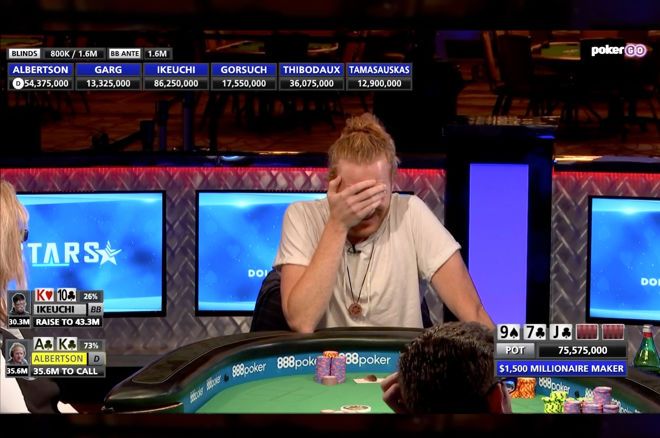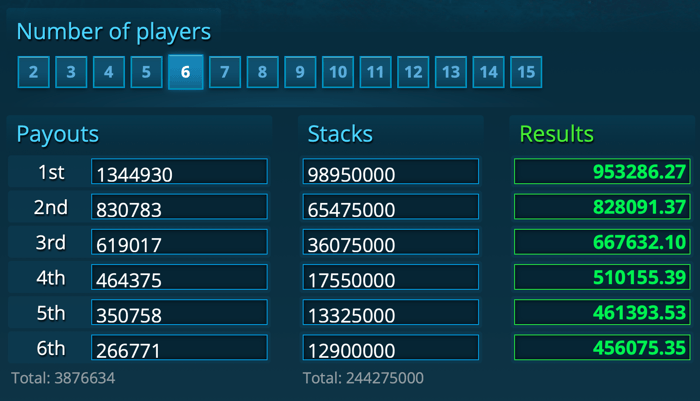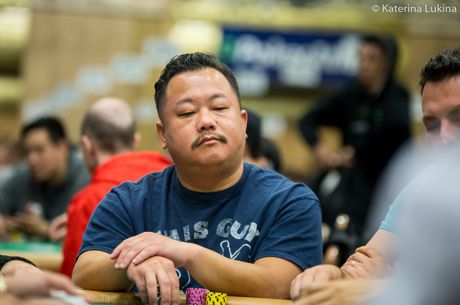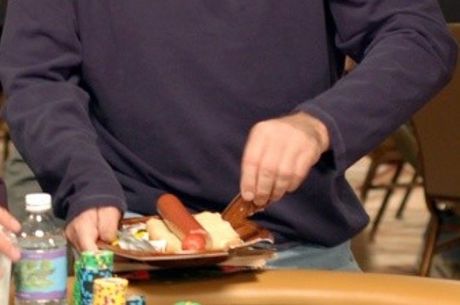Ryan Laplante Breaks Down Big-Stack Collision in the Milly Maker

Table Of Contents
Just after finishing in third place in Event #28: $1,000 No-Limit Hold'em at the World Series of Poker for his fourth-best career score of $154,268, bracelet winner Ryan Laplante talked with PokerNews about his run at bracelet number two. He also took the time to break down an interesting hand from the Millionaire Maker final table that played out the day before.
Laplante's Deep Run
Coming into the final table of six in Event #28, Laplante was nearly even in chips with four other players, all of whom were well behind chip leader Stephen Song who held just about half the chips in play. Laplante did work in the early levels of the day, finding a key double through Song with pocket kings versus pocket fives, then sending Renato Kaneoya to the rail when his ace-king suited held versus ace-ten suited to take over the lead by a small margin.
That lead wouldn't last long though, as Laplante got in a pretty dreamy spot only to lose the majority of his chips to Song.
Three-handed, Laplante raised the button and Song defended the big blind. They saw a flop of ace-ace-queen with two clubs and Song checked. Laplante continued for 400,000, got check-raised to 1.4 million, and put in the three-bet to 5.75 million.
"All I can do is just play my best and get it in in good spots and I did that, and it didn't work out."
Song didn't take long to move all in for his tournament life, holding a flush draw with 7♣3♣. Laplante was poised to take a massive lead into heads-up with his ace-ten for trip aces, but the J♣ turn and non-pairing river catapulted Song into the lead.
After that, Laplante was left on 11 big blinds. Despite doubling once, he was the next player out, running his suited ace into Song's bigger suited ace to bust.
When asked about the tournament and the final table play, Laplante had no regrets.
"I was in the zone the entire time," said Laplante. "I had pretty stone reads on everyone. I had a pretty good idea as to how to get people to do what I wanted them to and it worked out in my favor in that I got Stephen [Song] to shove on me — to four-bet shove with a flush draw — which I thought he would do, and he just got there."
As a seasoned professional poker player, Laplante isn't one to stress over that which he can't control, and this big spot with a bracelet on the line was no different.
"All I can do is just play my best and get it in in good spots and I did that, and it didn't work out. But I'm very happy with the score.... It's a very good result and I've been crushing this summer, so I'm very happy about it."

Huge Clash With ICM Implications in Millionaire Maker
Of the many interesting hands that played out during the Millionaire Maker final table on Wednesday, one stands out for stimulating a good deal of debate in the poker community for its major ICM (Independent Chip Model) implications.
With pay jumps at this point being in the six-figure range, the two overwhelming chip leaders at the six-handed final table played for stacks, while two others at the table had less than 10 big blinds and another had just 11 BBs. To give some perspective on the pay jumps the players were facing, here's a look at the top six payouts in the event:
Millionaire Maker Top Six Payouts
| Place | Prize Money |
|---|---|
| 1 | $1,344,930 |
| 2 | $830,783 |
| 3 | $619,017 |
| 4 | $464,375 |
| 5 | $350,758 |
| 6 | $266,771 |
As you might imagine given the set-up, this hand would involve the two big stacks, with the four others highly interested spectators.
With blinds at 800K/1.6M with a 1.6M big blind ante, Cory Albertson, who started the hand with 65,475,000 for 41 big blinds, opened to 3.3 million on the button with A♣K♣. Kazuki Ikeuchi, the big stack with 62 big blinds, was in the big blind and three-bet to 11.1 million with K♥10♣. Albertson opted to just call and they saw a flop of 9♠7♣J♣, giving both players draws.
Maria Ho: "If Ikeuchi puts you all in, you can't really call off, even if you are getting the right price."
Ikeuchi with the double gut-shot straight draw checked, and Albertson went with a small sizing of 7.7 million. Ikeuchi pounced on the bet, quickly announcing "all in" to put Albertson to the ultimate test in a spot where if he calls and loses, he's out and the four shorter stacks at the table ladder up.
After flopping so much equity with two overs and the nut-flush draw, Albertson said he didn't think he could fold, took a couple more minutes, then made the call.
When the hands were tabled, he saw he was indeed ahead, but would need to fade nine outs with two cards to come. After a blank turn, the 10♥ river gave Ikeuchi a pair of tens to win the hand and send Albertson out in sixth for $266,771.
Hand Analysis
Some initial hand analysis came from the PokerGO livestream commentators, Maria Ho and Ali Nejad, coming when action was on Albertson on the flop.
"One thing about these ICM spots is, when you flop a hand that has so much equity such as ace-king of clubs that has two overs to this board, that has the nut-flush draw, you want to be able to realize your equity," Ho said. "You don't want to be blown off of it. If Ikeuchi puts you all in, you can't really call off, even if you are getting the right price. You just feel really dirty about doing that, as the second [biggest] chip stack."
Ali Nejad reiterated the big pay jumps and the ICM implications for the second-biggest stack with three short stacks still in. Here's a look at an ICM breakdown of the final six players' stacks at the start of this hand, from the free online ICM calculator ICMIZER. As you can see from the breakdown, Alberton's stack was worth over $828,000 in "real-world" ICM value before this hand played out.

"I think Albertson should check back here, [and] hope to realize his equity," Ho said while Albertson contemplated a flop bet.
Nejad agreed. "It feels absurd to do it. Everything about your poker instincts says, 'Just pile! What's the worst that could happen? You have ace-king of clubs,'" said Nejad. "But stop, take a breath, survey the scenario and ask yourself, 'Do you really want to get involved with the chip leader — the one man that can bust you here?'"
Ho also pointed out that Ikeuchi had in his range some hands that he would three-bet with preflop and check-shove on this board texture after a bet from Albertson. As we now know, king-ten offsuit was in fact one of those hands, as he moved all of his chips in after Albertson pushed out a bet for around 30 percent of the pot.
Laplante Gives His Two Cents
Preflop Analysis
"I think the ace-king suited should have shoved preflop," Laplante told PokerNews after reading up on the hand. "Even with the short stacks in. The guy who ended up winning had the king-ten off, so obviously he's going to be three-betting exceptionally loose there. Let's say he's using like king-ten off, queen-ten off, a lot of hands like that. His three-bet calling range is probably only ace-king, queens-plus, which means he's probably bluffing today like 80-85 percent of the time, so when ace-king suited jams, it has like 85 percent fold equity."
"Let's say it's only 75 or 65 percent fold equity. Even at 65 percent fold equity, it's so much fold equity that it's a clear jam, that no other option is even remotely fine because when he does call, he gets into a spot that he got put into, which I actually think he has to stack off on that board texture," Laplante continued.
"Once you peel the ace-king and get put in that spot, you have to go with it. But that's the whole point as to why you just shove this preflop, so you're not put into this flop spot."
Laplante: "I think the ace-king made a massive error by not shoving preflop."
While he disagreed with Albertson's preflop play after getting three-bet, Laplante approved of Ikeuchi's play and told us why.
"I think the king-ten played it well. I think they're supposed to three-bet there. I think when they flop that amount of equity, it's a great spot to apply a lot of pressure. I mean the guy almost folded a hand that's a slam-dunk get it in, so yeah, I think the king-ten played it very well."
He reiterated the biggest mistake he saw in the hand, while acknowledging why some players may opt to play it in that more conservative manner preflop.
"I think the ace-king made a massive error by not shoving preflop, but it's understandable for a lot of people to want to call in that spot," said Laplante. "They see the other short stacks and think, 'Well, if I jam and I get called, you know, it really sucks. Which yeah, it does suck, but when you get called like 25 percent of the time.... I mean, 75 percent of the time you chip up very nicely and you just make a lot of money, and then when you do get called, it's such a low frequency that it doesn't really matter."
Postflop Analysis
Once he does opt to just call the three-bet preflop, we asked Laplante what the best options are at that point when checked to, with around 1.8 pot-sized bets behind (also known as SPR, stack-to-pot ratio).
"He has to go with it," Laplante said. "I think they should just shove or maybe bet larger; I don't like the small bet."
He laid out the different options in order of preference: "He should just shove, or check back. I think betting small to stack off is probably the worst option. I think shoving or checking are both fine, I'd be completely okay with either. I'd lean toward jamming, though."
You can watch the hand play out in the following clip provided by PokerGO via Twitter.
How would @MariaHo handle this sick Millionaire Maker ICM spot? Watch the breakdown and then watch the final table… https://t.co/ntzaYlCCKb
— PokerGO (@PokerGO)
Judge for yourself:








